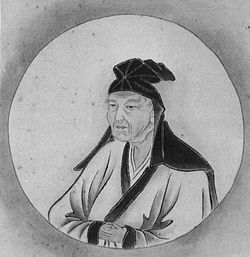Confucian Shinto, also known as Juka Shintō (儒家神道) in Japanese, is a syncretic religious tradition that combines elements of Confucianism and Shinto.[1][2] It originated in Japan during the Edo period (1603–1868), and is sometimes referred to as "Neo-Confucian Shinto"[3]

Modern organizations include Shinto Taiseikyo,[4][5] Shinto Shusei,[4][5] and Tsuchimikado Shinto.[6] Suika Shinto was a major school of Confucian Shinto.[7]
History
editThe roots of Confucian Shinto can be traced back to the 17th century, when Japanese scholars began to study Chinese Confucian texts and integrate Confucian ideas into their understanding of Shinto. The most notable of these scholars was Yamazaki Ansai (1618–1682), who developed a synthesis of Confucianism and Shinto that emphasized the importance of ethical behavior and filial piety.[1] Ansai's teachings were further developed by his disciple, Kaibara Ekken (1630–1714),[8] who wrote a number of influential works on Confucian Shinto, including the "Greater Learning for Women."[9] Ekken's writings emphasized the importance of education and the cultivation of virtue, and advocated for the integration of Confucian ethics into everyday life.[10]
In the 18th and 19th centuries, Confucian Shinto became increasingly popular among the samurai class, who saw it as a way to reconcile their duty to the emperor with their Confucian ideals of loyalty, honor, and righteousness.[1] Confucian Shinto also gained a foothold among commoners, who were attracted to its emphasis on family values and practical ethics.[2] Wang Yangming's concept of union of knowledge and practice was highly influential on Confucian Shinto.[1]
Influence and legacy
editConfucian Shinto had a significant impact on Japanese society during the Edo period and beyond. It helped to shape the moral values and social norms of the samurai class,[1] and played a role in the development of modern Japanese nationalism.[7]
Confucian Shinto also had an influence on the Meiji Restoration of 1868, which marked the end of the Edo period and the beginning of modern Japan. The leaders of the restoration sought to revive traditional Japanese values and culture, and saw Confucian Shinto as a way to do so. They promoted the idea of kokutai, or the "national essence", which was based on the Confucian notion of the ruler-subject relationship and the Shinto idea of the emperor as a divine being.[7] Fukko Shinto which was also quite significant developed in reaction to Confucian Shinto,[11][12] and it was the predecessor to State Shinto.[13]
Modern groups
editAmong Sect Shinto, Shinto Taiseikyo (神道大成教) and Shinto Shusei are considered Confucian influenced groups.[14] Tsuchimikado Shinto continues the legacy as well,[6] but it is not a member of the sect Shinto association.
References
edit- ^ a b c d e "Perspectives toward Understanding the Concept of Kami". www2.kokugakuin.ac.jp. Retrieved 2023-03-06.
- ^ a b "Encyclopedia of Shinto詳細". 國學院大學デジタルミュージアム (in Japanese). Retrieved 2023-03-10.
- ^ Kun-chiang, Chang (2018-10-02). "Neo-Confucian Shinto Thought in Early Tokugawa Zhu Xi Studies: Comparing the Work of Hayashi Razan and Yamazaki Ansai". Contemporary Chinese Thought. 49 (3–4): 219–240. doi:10.1080/10971467.2018.1654823. ISSN 1097-1467.
- ^ a b "The Forms of Shinto". Caroline Myss. Retrieved 2023-03-06.
- ^ a b "Kyōha Shintō | Japanese religion | Britannica". www.britannica.com. Retrieved 2023-03-06.
- ^ a b "Encyclopedia of Shinto詳細". 國學院大學デジタルミュージアム (in Japanese). Retrieved 2023-03-10.
- ^ a b c "Japan - Shintō and kokugaku | Britannica". www.britannica.com. Retrieved 2023-03-07.
- ^ Josephson, Jason Ā. (2012). The Invention of Religion in Japan. Chicago: University of Chicago Press. pp. 115–6. ISBN 9780226412351.
- ^ See excerpt (hosted by George Mason University)
- ^ "Kaibara Ekken | Encyclopedia.com". www.encyclopedia.com. Retrieved 2023-03-07.
- ^ 全国歴史教育研究協議会. 日本史B用語集―A併記 (改訂版 ed.). 山川出版社. ISBN 9784634013025.
- ^ 平重道「儒家神道」『国史大辞典』第7巻、吉川弘文館、1986年 ISBN 4-642-00507-2 Page 321
- ^ 日本史用語研究会. 必携日本史用語 (四訂版 ed.). 実教出版. ISBN 9784407316599.
- ^ "Kyōha Shintō | Japanese religion". Encyclopedia Britannica. Retrieved 2023-03-06.